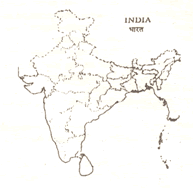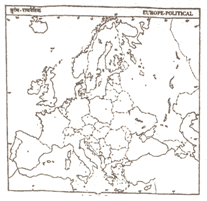- English
- Sociology
- Functional English
- Psychology
- Mathematics
- Philosopy
- Physics
- Computer Science
- Chemistry
- Entrepreneurship
- Biology
- Informatics Practices
- Geography
- Multimedia & Web Technology
- Economics
- Biotechnology
- Business Studies
- Physical Education
- Accountancy
- Fine Arts
- Political Science
- History
- Agriculture
CBSE Guess > Papers > Question Papers > Class XII > 2005 > History > Delhi Set-I
HISTORY 2005 (Set-I Delhi)
PART - A
(MODERN INDIA)
Q. 1. Explain briefly any two main achievements of Bahadur Shah I. 2
Q. 2. What Was the Queen’s Proclamation of 1858’? 2
Q. 3. Who founded the Brahmo Samaj? Mention any one of its principal aims. 2
Q. 4. Who founded the Arya Samaj ‘? Describe the role of Arya Samaj In the social awakening of India. 1+4
Or
Discuss the main objectives of the East India Association founded in London Who founded the association? 4+1
Q. 5. Explain three main reasons for the foundation of Indian National Congress in 1885 and name of the two Britishers who had helped in its foundation. 3+2
Or
What were the main demands of the Moderate nationalists? Mention their two main achievements.
Q. 6. Explain the importance of the revolutionary movements in the freedom struggle of India. 5
Or
Explain how the Home Rule movement was neither entirely moderate nor was thoroughly revolutionary. 5
Q. 7. Why was the Khilafat movement started? Explain its political significance. 5
Or
Explain the main aspects of the constitutional changes introduced in 1919. Examine the nationalist’s reactions to these changes. 3+2
Q. 8. Explain any four achievements of the congress ministry formed after 1937. Mention any two states where the congress had formed ministries. 4+1
Or
What was Mountbatten Plan? Explain its main outcome?
Q. 9. Examine the main reasons which prompted the Europeans to come to India during the 16th and 17th centuries. Explain how India was portrayed in Euro- pean writings during the period. 5
Or
Explain any two main objectives of te East In4ia Company at the time of its foundation. Explain the main features of its structure and mention the British Governments relations with the company. 2+4+2
Q. 10. Describe the economic causes of the revolt of 1857 and mention any two revolts which preceded it. 6+2
Or
Why did the revolt of 1857 fail? Mention two Indian rulers who sided with the British during the revolt?
Q. 11. Critically analyse the nature of freedom struggle in Goa. When was Goa fina- lly liberated? 7+1
Or
Read the following passage and answer the questions that follow –
“In order to settle the issue immediately and prevent the slaughter of innocent people, the Congress decided to agree to the division of the country and dem- anded the partition of the Punjab and Bengal. This was no surrender to the Muslim League or policy of appeasement.”
1. Why did the Congress accept the partition of India is 1947? 1
2. Why did the Muslim League demand a separate and independent state? 2
3. Do you agree with the view that the acceptance of the demand for the partition of the country was an act of appeasement? Give reasons. 5
Q. 12. On the given outline map (Political) of India locate and label the following as on 15th August, 1947. 5
a) Two French regions.
b) Two Portuguese regions
c) One Princely State
Or
On the given outline map (Political) of India locate and label the following chi- ef centres of Revolt of 1857.
a) Two centres in Karnataka
b) Two centres in Andhra Pradesh
c) One centre in Kerala.

PART - B
(CONTEMPORARY WORLD HISTORY)
Q. 13. What is meant by covenant of the League of Nations? 2
Q. 14. Explain the meaning of blitzkrieg in the context of World War II. 2
Q. 15. Describe one main reason of Arab-Israel conflict in contemporary history. 2
Q. 16. What is meant by “Globalization”? 2
Q. 17. Mention the two indicators of an advanced society or a State? 2
Q. 18. Mention any main characteristics of the Modern Japanese novel. 2
Q. 19. Explain the meaning of Contemporary period in history. Mention how it is diff- erent from the modern period. 3+2
Or
Explain the basis of Ango-French. entente of 1904. Mention one of its main consequences. 4+1
Q. 20. Describe the main reasons for the rise of Nazism in Germany. Mention one of its main outcome. 4+1
Or
What led to the social crisis in Britain during the inter-war period? Mention when were the women given the right to vote there.
Q. 21. Critically analyse the success of the Communists in China in 1949. Mention the name of their main leader? 4+1
Or
Explain the post II World War developments in Vietnam and assess the role of the United States of America in It. 5
Q. 22. Explain the main developments during the World War II which led to Germa- ny’s surrender. Explain two main outcomes of her
Or
Explain the term “decolonization”. Examine how the process of decolonization got strength after the World War II. Name one country which was decolonised soon after World War II. 2+5+1
Q. 23. On the given outline map of Europe locate and label five countries which Acti- vely participated in the World War I. 6
Or
On the given outline map of Europe, locate and label three neutral countries and two allied countries during the World War II.

| History 2005 Question Papers Class XII | |||
| Delhi | Outside Delhi | ||
| Set I | Set I | ||
| Set II | Set II | ||
| Set III | Set III | ||
